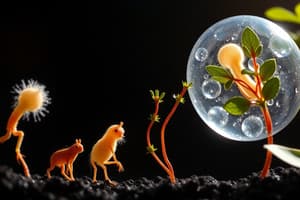Podcast
Questions and Answers
When did the first single-celled organisms, known as prokaryotes, appear on Earth?
When did the first single-celled organisms, known as prokaryotes, appear on Earth?
Around 3.5 billion years ago
When did the evolution of vertebrates, or animals with backbones, occur?
When did the evolution of vertebrates, or animals with backbones, occur?
Around 520 million years ago
What was the Earth like for the first billion years after its formation?
What was the Earth like for the first billion years after its formation?
It was a molten mass of liquid rock
What is the defining feature of eukaryotic cells?
What is the defining feature of eukaryotic cells?
During which period did the Cambrian Explosion occur?
During which period did the Cambrian Explosion occur?
From what did humans evolve?
From what did humans evolve?
What defines mammals?
What defines mammals?
When did humans first appear as a species?
When did humans first appear as a species?
When did mammals first appear?
When did mammals first appear?
What led to the emergence of humans?
What led to the emergence of humans?
During the Archean Eon, single-celled organisms such as bacteria and archaea began to emerge, driven by ______.
During the Archean Eon, single-celled organisms such as bacteria and archaea began to emerge, driven by ______.
The ______ Eon marked the beginning of life on Earth.
The ______ Eon marked the beginning of life on Earth.
The Proterozoic Eon saw the emergence of ______, organisms with membrane-bound nuclei and other cellular organelles.
The Proterozoic Eon saw the emergence of ______, organisms with membrane-bound nuclei and other cellular organelles.
Eukaryotes were larger and more complex than their bacterial and archaeal ______.
Eukaryotes were larger and more complex than their bacterial and archaeal ______.
Life on Earth has undergone a fascinating ______ journey, spanning billions of years.
Life on Earth has undergone a fascinating ______ journey, spanning billions of years.
The Cambrian Explosion marked the transition from simple, bilaterally symmetrical organisms to more complex, ______ life forms
The Cambrian Explosion marked the transition from simple, bilaterally symmetrical organisms to more complex, ______ life forms
During the Proterozoic Eon, the Earth's atmosphere gradually became more hospitable, with oxygen levels gradually increasing due to the activity of ______ organisms
During the Proterozoic Eon, the Earth's atmosphere gradually became more hospitable, with oxygen levels gradually increasing due to the activity of ______ organisms
The Paleozoic Era was characterized by the rise of ______ life, with the emergence of plants, particularly vascular plants
The Paleozoic Era was characterized by the rise of ______ life, with the emergence of plants, particularly vascular plants
The Mesozoic Era was the age of the ______, marked by the emergence of numerous new species
The Mesozoic Era was the age of the ______, marked by the emergence of numerous new species
The Cenozoic Era saw the evolution of modern mammals, including ______
The Cenozoic Era saw the evolution of modern mammals, including ______
Flashcards are hidden until you start studying
Study Notes
The history of life on Earth is a fascinating subject that spans billions of years. From the formation of the first single-celled organisms to the emergence of multicellular life and eventually human beings, the journey of life on Earth has been an incredible evolutionary process.
The Early Earth
The Earth was formed approximately 4.5 billion years ago, and for the first billion years, it was a molten mass of liquid rock. It wasn't until around 3.5 billion years ago that the first single-celled organisms, known as prokaryotes, appeared. These organisms were simple and lacked a nucleus, the control center of a cell.
The Emergence of Eukaryotes
Around 2 billion years ago, prokaryotic cells began to evolve into eukaryotic cells, which are more complex and have a nucleus. These organisms were the first multicellular life forms on Earth, and they laid the foundation for the evolution of more complex life forms.
The Cambrian Explosion
The Cambrian period, which occurred approximately 541 to 485 million years ago, was a time of rapid evolution in multicellular life forms. This period saw the emergence of a wide variety of new species, many of which were the ancestors of modern groups of animals.
The Evolution of Vertebrates
The evolution of vertebrates, or animals with backbones, occurred around 520 million years ago. These early vertebrates were fish, which eventually evolved into amphibians, reptiles, birds, and mammals.
The Rise of Mammals
Mammals, which are warm-blooded animals that produce milk to feed their young, first appeared around 200 million years ago. Over time, mammals evolved into a diverse range of species, including the first primates, which eventually led to the emergence of humans.
The Emergence of Humans
Humans, as a species, first appeared around 200,000 to 300,000 years ago. Our ancestors were early members of the Homo genus, and they evolved from an African ape-like ancestor.
In conclusion, the history of life on Earth is a complex and fascinating journey that has spanned billions of years. From the formation of the first single-celled organisms to the emergence of human beings, the evolution of life on Earth has been a remarkable process that continues to shape the world around us today.
Studying That Suits You
Use AI to generate personalized quizzes and flashcards to suit your learning preferences.




